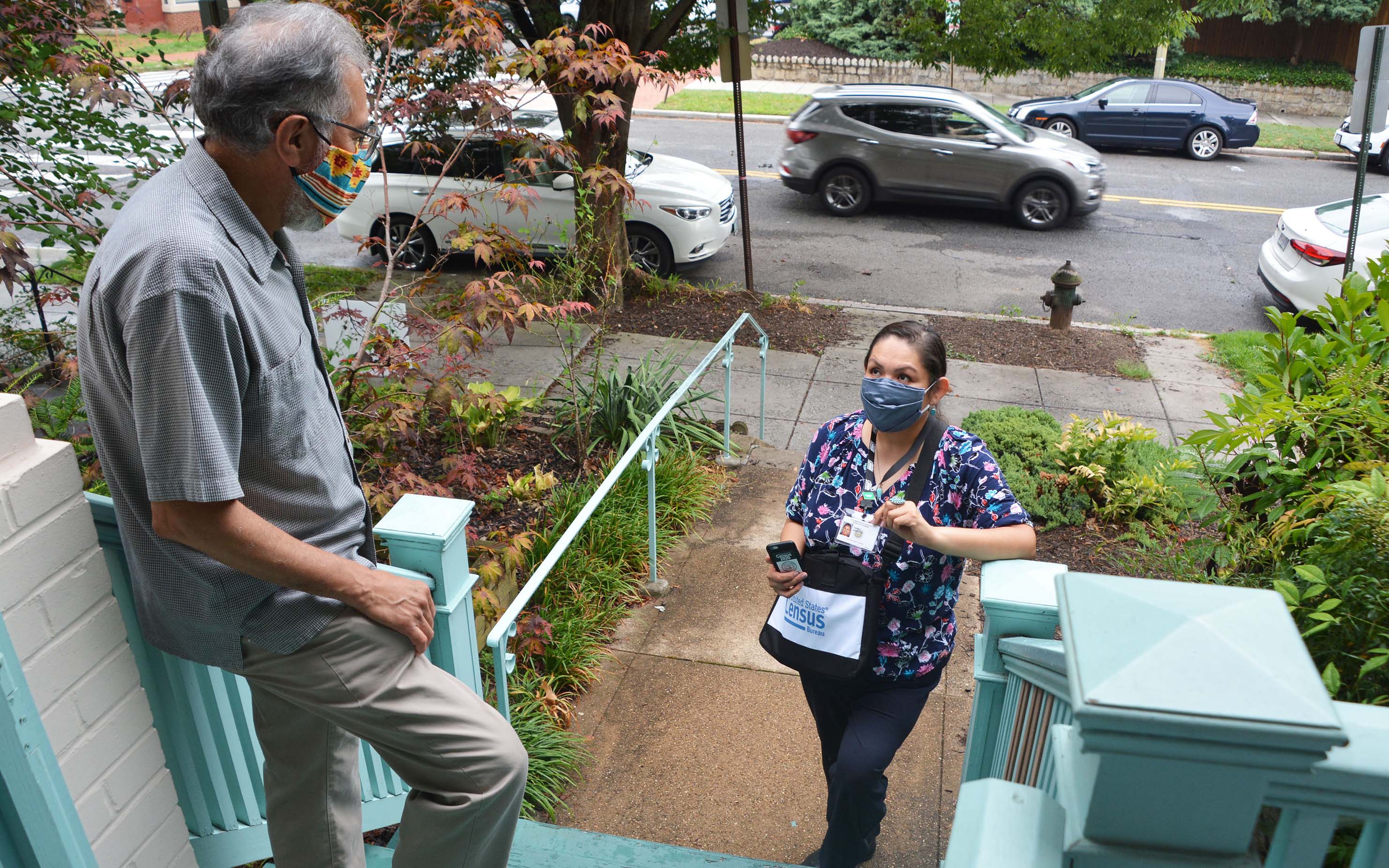COVID-19 complicates 2020 Census response ahead of Sept. 30 deadline
August 17-23, 2020
By Daily Record Staff
With Arkansas well behind most of the nation in responding to the 2020 Census, local and state officials are accelerating efforts to get Arkansas residents to response to the decennial survey so that the Natural State won’t be undercounted or lose out on future federal funding.
This past week, the City of Little Rock has begun holding a slate of “Census Saturday” events at area grocery stores through the end of the month to get city and county residents to complete the decennial questionnaire.
Up until Aug. 29, city staff and volunteers will have mobile hot spots at local grocery stores to help residents complete the Census. Staff and volunteers will be observing local, state and federal guidelines on social distancing and wearing face coverings and will be sanitizing devices used by residents to complete their census, officials said.
In late July, the Census Bureau began sending out reminder postcards to an estimated 34.3 million U.S. households. This will be the final mailing before census takers begin visiting nonresponding households across the nation in mid-August. Responding now minimizes the need for census takers to visit homes to collect responses in person.
According to the Census Bureau’s online map that tracks the nation’s participation in the census, more than 93.3 million, or 63.1% households, have already responded online, by phone or by mail as of Aug. 10. In Arkansas, more than 880,000 households have completed the 2020 Census questionnaire, putting the state’s current response rate at 57.9%, which ranks 41st out of all 50 states, the District of Columbia and U.S. territories.
Minnesota, Wisconsin and Nebraska have the nation’s highest response rates at 72.5%, 69.8% and 69.2%, respectively. New Mexico, Alaska and Puerto Rico have lowest response rates at 53.5%, 50%, and 28.8. Census takers will interview homes that have not responded to the 2020 Census to help make sure everyone is counted.
The COVID-19 pandemic delayed the nationwide start of census taker visits from mid-May to mid-August, giving the Census Bureau the chance to send one more reminder to households encouraging them to respond on their own. The Census Bureau, which is part of the U.S. Department of Commerce, will deliver apportionment counts to the President and Congress as required by law in December.
Census changes causes controversy
On Aug. 3, U.S. Census Bureau Director Steven Dillingham said the bureau continues to evaluate its operational plans to collect and process data. Dillingham also announced controversial updates that will include enumerator awards and the hiring of more employees to accelerate the completion of data collection and apportionment counts by our statutory deadline at the end of 2020, as required by law.
At the time, Dillingham said that he had been directed by the Trump administration and Department of Commerce, which oversees the Census Bureau, to end field data collection by Sept. 30, including so-called hard-to-count populations that are traditionally located in minority, rural and below-poverty-level census tracts.
“The Census Bureau’s new plan reflects our continued commitment to conduct a complete count, provide accurate apportionment data, and protect the health and safety of the public and our workforce,” said Dillingham. “Under this plan, (we) intend to meet a similar level of household responses as collected in prior censuses, including outreach to hard-to-count communities.”
And due to earlier COVID-19 concerns and the difficulty in getting canvassers on the ground local due to social distancing nationwide, the previous deadline to respond to the Census 2020 had been extended to Oct. 31. Under the new tighter deadline, Dillingham said the bureau’s Nonresponse Follow-up (NRFU) operation is the final stage of conducting the once-a-decade population count of everyone living in the U.S.
Households can still respond now by responding online at 2020census.gov, by phone at 844-330-2020, or by completing and mailing back the paper questionnaire they received. Households that have responded online or by phone in one of 13 languages will not need to be visited to obtain their census response.
“America has answered the call and most households responded to the census online, by phone or by mail,” said Dillingham. “To ensure a complete and accurate count, we must now go door to door to count all of the households we have not heard back from.”
Arkansas undercount, FEW doorknockers
In an email communique regarding Dillingham’s recent testimony before Congress concerning the new Sept. 30 deadline, the Arkansas Counts coalition warned that the earlier deadline supported by the Trump administration court hurt Arkansas financially over the next decade. Kara Wilkins, spokeswoman for the nonprofit statewide coalition, said in a that not having traditionally census canvassers knocking on doors after September could cause Arkansas to lose up to $42 billion in federal funding over the next decade due to an undercount.
“A rushed census in the midst of a pandemic cuts short our efforts to ensure children under five, people of color, rural residents, low-income people, and people experiencing homelessness count,” said Wilkins, a recent email memo. “This will skew Congressional representation, redistricting, and critical funding for every state in the country, including Arkansas.”
According to public-private coalition urging residents across the state to complete the census, Arkansas received more than $9 billion from federal spending programs based on information from the 2010 census. A one percent undercount of Arkansas in 2020 may result in up to nearly $1 billion in lost funds over the next 10 years, the group said.
Even after getting off to a delayed start this spring, the 2020 Census is likely to be the most expensive in U.S. history — projected to cost over $15 billion. According to a recent report by the U.S. Governmental Accountability Office (GAO), the success of the decennial population count largely depends on how well the Census Bureau manages upcoming peak operations as the COVID-19 virus spreads across the country.
Based on the Census Bureau’s digital map, Arkansas’s self-response rate is 4.4 points behind its final 2010 rate, meaning a greater share of non-responding homes will need to be counted in-person — an especially challenging task now that the Census Bureau has shortened the door-knocking timeframe by 4 weeks.
About 901,000 Arkansas households have filled out the questionnaire on their own to date, according to the Census Bureau online map. That means about 655,130 homes need to be visited by a census taker to count everyone else in-person or to determine if housing units are vacant.
The self-response rate does not mean only that percentage of Arkansas’s population was counted in 2000 and 2010, or as the 2020 Census count unfolds. Instead, it represents the percent of households that mailed back their census forms on their own. The Census Bureau still must count the remaining households in person during the nonresponse follow-up operation. But there is a greater risk that some people will be missed or counted incorrectly, officials said.
In a June 4 analysis of U.S. Census Bureau data, the Urban Institute in Washington, D.C., estimated that as many as 27,600 Arkansas residents may be undercounted in 2020. This projection could be reduced if Arkansas’s self-response rate is higher than expected
An undercount in the 2020 Census is likely inevitable. The big question is by how much. Demographic changes over the last decade suggest that the population in 2020 will be harder to enumerate,” said Urban Institute researcher Diana Elliott. “Hard-to-count groups — including complex households, renters, young children, immigrants, and people of color — will represent a larger share of the population in 2020 than they did in 2010.
Our projections show that even under the lowest-risk scenario — where we assume that the 2020 Census will perform exactly as the 2010 Census did — the national population count will be less accurate,” concluded Elliott, principal research associate for progressive economic research group.
Besides Arkansas Counts and the City of Little Rock’s effort to improve Arkansas’ response rate, Gov. Asa Hutchinson signed an executive order a year ago to create the state Census 2020 Complete-Count Committee. That 20-person public-private panel, led by Fort Smith Mayor George McGill, also was created by the governor to ensure all Arkansas residents are accurately counted during the 10-year survey, especially in areas of the state determined as “hard-to-count” census tracts.
Officially, the Census Bureau recently projected that the U.S. population was 330,222,422 on Jan. 1, 2020. This represents an increase of 1,991,085, or 0.61%, from New Year’s Day 2019. Since that last census in 2010, the population has grown by 21,476,884 or 6.96%. Those same estimates put Arkansas’ current population at 3,017,804, up 3.5% or 101,773 from a decade ago.
That ranks Arkansas has the nation’s 33rd-largest state, sandwiched between Nevada and Mississippi at 32nd and 34th respectively. Arkansas mostly rural population surpassed the 3 million mark for the first time in state history at the end of 2017, according to Census Bureau estimates.
PHOTO CAPTION: (Photos provided)
On Aug. 11, the U.S. Census Bureau began the final stages of the once-a-decade population count ahead of the revised Sept. 30 deadline. Census Bureau canvassers have begun knocking on doors locally to urge nonresponsive Arkansans to complete the 2020 Census. Arkansas ranks 41st among all 50 states and U.S. territories in responding to the decennial questionnaire.




